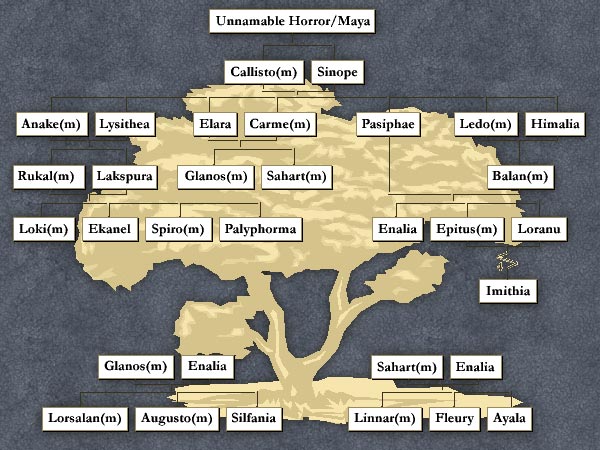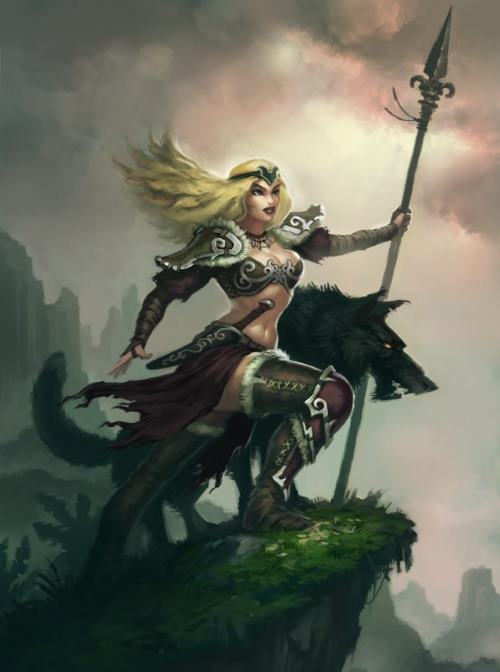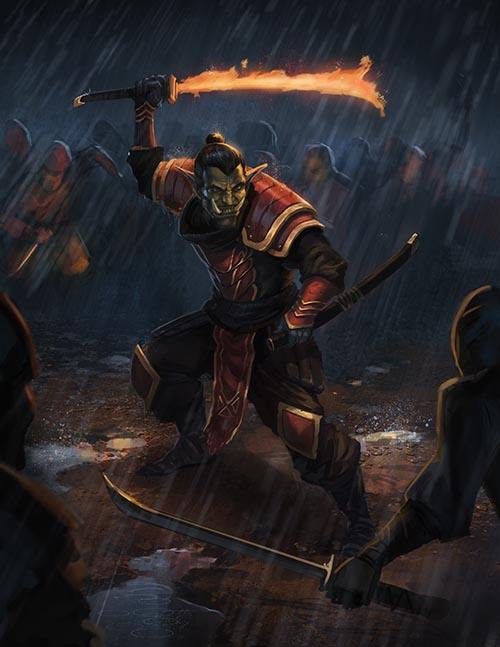The History of the Mortal Races
Read about the origins of Humanity, the founding of the original two city-states - Ashtan and Shallam - and the other four original mortal races - Tsol'aa, Dwarves, Trolls, and Mhun.
Chapter List
Maya's Legacy
When Maya the Aldar was raped by the Unnamable Horror, the course of history was changed forever. War among the Gods broke out and eventually Ayar himself took a hand. After many years of gestation and a long, painful childbirth, Maya gave birth to two strange babies. Smaller by far than any Aldar babies, these 'humans' were also weaker and were born with a tabla rasa; a blank mind. Aldar children are born with inherited memories and skills and are immediately capable of caring for themselves. The Aldar laughed and mocked them, calling them weak and pitiful. When Proteus declared that the children would be the inheritors of the continent of Sapience on the world of Achaea, Aldar dissent grew and exploded across the cosmos into the Chaos Wars (see Mythology).
Maya loved and cared for her two offspring, the male of which she called Callisto and the female, Sinope. As they developed and grew, the two human children were constant companions. As a natural outgrowth of this closeness, and because they had been charged by Proteus to become the progenitors of a new race, they became lovers. We of the modern age, with our iron weapons, sophisticated warfare, and learned scholars may consider this evil, but let us not forget that times were different then. This was the age of legends, and we have no right to judge these heroic figures of antiquity with our modern morality. Sinope bore Callisto seven children, collectively known as the Offspring. Four of them - Pasiphae, Elara, Lysithea, Himalia - were female, while the other three - Carme, Anake, and Ledo - were male.
As Sinope and Callisto grew older, it became apparent that they were not aging. It seemed that they possessed the near-immortal lifespans of the Aldar and would never perish of natural causes. However, Lucretius, God of Knowledge, theorized that as the generations of humans came and went, each succeeding one would possess less and less of this long lifespan, until they were as other mortals. He went on to explain this as being a result of the interbreeding of pure Chaos, in the form of the Unnamable One, with Aldar. The entropic energy would cause the Aldar energy to dissipate over time, leading to lifespans more on par with the lifespans of the other mortal races.
Soon after the birth of the Offspring, Proteus, Phaestus, and Daedalus came to Achaea with the Sceptre of Divinity. They broke the sceptre into seven pieces and gave one to each of the Offspring, saying that whomever could unite these pieces into one would attain rewards beyond imagination. Sinope and Callisto were dismayed at this, for they did not wish to see their burgeoning race torn apart by strife. They had raised their children well though, and, taking the advice of their parents, the Offspring agreed never to strive for domination over the others. The Gods were pleased with this compact, and created a wonderous valley called Ceylon, which means Golden Land, for the humans to dwell in.
Soon after this, the battle on Nishnatoba took place, but the humans, with their limited perceptions, knew none of it. Never did they know, until later generations came and established close relationships with the Gods, how close they came to being exterminated, and what an impact their birth had upon all Creation.
Anake's Passion
Life went on for a century. Many children were produced by the Offspring, as they interbred. Sinope and Callisto kept to themselves, watching their loving creations grow and multiply. There was no stigma about inter-breeding, for all were related anyhow. Sinope, however, refused to take another lover. Anake, who found his mother very fetching and her refusal to sleep with him vexing, plotted secretly and killed her one night as she slept. Callisto was out on a hunting trip with Ledo, Pasiphae, and Himalia at the time. Carme, upon stumbling onto his dead mother, cried out in dismay and quickly got Lysithea to gather the other Offspring while he went to bring back Callisto and the rest of the hunting party. Despite this, Anake almost got away with it, except that Maya herself came down and informed them that it was he, Anake, who had betrayed the mother of Humanity and killed her.
This announcement by Maya caused great outrage in Ceylon. Callisto sequestered himself, for he was too broken with grief to think of revenge or justice. Carme, Elara, Ledo and Himalia all counciled banishment from Ceylon for Anake. Pasiphae, the most beautiful and caring of them all, could not bear the thought of never seeing her brother again, but did not support him for she understood the rage the others felt. Only Lysithea would support her brother, arguing that they had all agreed never to seek domination over the others, and Anake had not technically broken that agreement since Callisto and Sinope were not part of it. The majority of the Offspring would not hear of it though, so outraged were they at the death of their mother, who was the most perfect human in history. All later humans are merely shades of their dead mother. Anake was banished and to the sorrow of the rest of the Offspring, Lysithea decided to go with him, for she and her brother had always been closest.
Blood Feuds
As they burned the body of Sinope, Callisto entered into a state of grief for the next 50 years and refused to speak or participate in any human activity. He was found often staring into the sky, mumbling to himself and weeping. One day, the Gods Shaitan and Thoth, sensing the potential in humanity that Caymus, the Aldar prophet, first did, and wishing to use them for their own purposes, appeared to Callisto and argued that Anake should suffer for his terrible deed. They conjured up vivid visions of beautiful Sinope, and Callisto became mad with grief. Screaming out his rage, he left Ceylon, unseen by his children and grandchildren and spent fourteen years in the wilderness, tracking down Anake. When he finally found them, he was more animal than human. He rushed into the forest dwelling that Anake, Lysithea, and their only two children, Rukal and Lakspura inhabited, and brutally killed Anake while he slept. As he slit Anake's throat with a piece of sharp obsidian, Anake's blood splattered Callisto's face. Callisto, feeling the blood of his son flowing down his face in smooth rivulets, went irreparably insane.
Running and screaming, tears streaming down his face as he pleaded with Sarapis to end his miserable life, he was grabbed by a pair of hands from above. Quickly they wrapped a rope around his neck, dropped him, and hung him. As Callisto's neck snapped, Rukal and Lakspura looked at each other with satisfaction, having avenged their father's death at the hands of their grandfather.
Generations
Rukal and Lakspura mated and produced four children: Loki, Ekanel, Spiro, and Polyphamora. They lived among the animals and learned to disguise themselves from danger, and learned the language of the beasts. As chaos was still very strong in the blood of humans, their offspring had many mutations. Of the four, two, Loki and Ekanel, appeared slightly serpentine. During childhood, as the foursome was out hunting in the woods for small animals, Loki and Ekanel killed and ate Spiro and Polyphamora, much to the surprise of their parents. Rukal and Lakspura, realizing that it was best for the strong and crafty to survive, never even commented on the deaths. Loki and Ekanel lived long and produced many offspring, some of which became the forebears of the modern Serpentlords.
All the Offspring had children, but some warrant particular attention. Elara and Carme had a great number of children, but the strongest two were Glanos and Sahart. They both, Sahart first, then Glanos, seduced and impregnated Enalia, daughter of Pasiphae and Balan, who was himself the son of Ledo and Himalia, two of Pasiphae's fellow Offspring. Of them, more will be said later, for the story of Glanos and Sahart and their descendants is the story of mankind.
Epitus, the brother of Enalia (daughter of Pasiphae and Balan) had a close relationship with the Gods. He was extremely pious and the Gods almost universally looked upon him with good will. His great-great-granddaughter, Imithia built the first formal temple and later the first church. The first rite held in the new Church was the Rite of Ending for Pasiphae, the last of the Offspring who was not either dead or missing.
Tales of the Offspring
The tales of the seven Offspring are interesting ones and we shall expand upon them here.
Of Anake, you know. The first murderer, he slew his own mother after she refused his advances and was later slain by his father.
After the death of Anake, Lysithea yearned to bring him back. She was contacted by Lorielan, who now rules over the Kx'Khrah. Lorielan promised that she could bring Anake back to life if Lysithea would simply bring her the two pieces of the Divine Rod that she now had. Lysithea, knowing she could never again enter Ceylon to gain the other five anyhow, agreed and was brought to Lorielan by one of her Kx'Khrah agents. Lorielan had lied, as is her nature, and upon the arrival of Lysithea, the Offspring was forced to give up the pieces of the Rod to Lorielan, and, being stranded on a foreign plane with no way to return, was forced to serve Lorielan forever.
Ledo was always the silent recluse; the solitary hunter. During a hunting trip in the Vashnar mountains, he disappeared and never returned. It was later discovered that he had been attacked and eaten by a lesser dragon.
After the death of his mother and the resulting grief and then madness of his father, Carme took over leadership of the budding human race. He yearned to explore and was lost to Achaea when he ventured into the great northern wastelands, and never returned. The others mourned his loss greatly, for he was a natural leader of men. Over the centuries, however, legends have filtered back to the civilized portion of Sapience that a lone man has occasionally been seen, accompanied by humanoids that look very much like Tsol'aa, in the polar regions.
The mother of mankind's eternal fascination with the ocean, Himalia sailed off to the west in a small boat, by herself. Searching for lands rumoured to be on the other side of the world, she did not expect to return, and indeed, she did not. Her fate is unknown, though much speculated upon.
After Lysithea was lost to the Crystal Plane, Elara began searching for an entrance into it. As she was experimenting with opening doors to other planes, a great scaled hand reached out from a doorway. As Himalia and Ledo looked on, helpless to do anything, Elara was dragged screaming through the doorway and was never seen again.
Last of the Offspring to remain in Ceylon, Pasiphae died a natural death after many hundreds of years of life. Imithia delivered her eulogy at what is considered the first formal function of the Church.
Family Tree

Humanity's family tree.
The Founders
The story of humanity is, as I have previously written, the story of the Glanos, Sahart, Enalia, and their offspring. Glanos and Sahart were brothers and possessed the irresistible charisma of their father, Carme. They both took Enalia as lover and both sired three children by her. Hopelessly in love with them both, she was unable to choose between them and so vacillated weakly, bearing each of them children. Though at first each professed not to care, their pride was too great for them to stand the thought of his lover sleeping with his greatest rival. Great friends initially, this jealousy ruined their friendship and, in lieu of coming to blows, they went from Ceylon and journeyed in different directions.
Glanos settled finally in an area of plains near the Western Ocean and at the northern end of the Vashnar mountains, while Sahart came finally to the Peshwar delta near the Eastern Ocean and settled at the southern end of a great, lush valley. These two brothers, formerly virtual partners in everything, never saw each other again. With each came his children, grandchildren, and various allies amongst the other humans, until over half the humans had gone to rally around either Glanos or Sahart.
The places that Glanos and Sahart settled were, of course, eventually became known as Ashtan and Shallam, respectively. Time passed and though there were legends in each city of the other, there was no contact between the two for a millennia. When they finally did re-discover each other, it was with animosity in their hearts. Each searching for a source of precious metals without the risks of the perilous Vashnar mountain range, they met north of the Siroccian mountains, within which both had discovered significant mining potential. Initially only wary of each other, they quickly mustered arms to protect these new-found resources and began their legendary conflict.
Though the battles they fought and the campaigns against each other that they won and lost are too numerous to be described individually, the ebb and flow of the campaign took place in three distinct cycles.
A Tale of Two Cities
In the first cycle, which lasted approximately 750 years, Shallam was able to control much of the explored mainland and with it, built itself into a city of legendary beauty. Covered in mother of pearl and gold leaf, its characteristic domes and spires glistened from horizon to horizon. Between the fanatical loyalty that the city inspired in its citizens, and the vast warchest it had with which to hire mercenaries, Shallam was able to invade and capture Ashtan itself. Under the leadership of Darius, a nephew of the Emperor, Shallam executed a two-pronged attack against Ashtan, captured the Royal complex there, and declared dominion over all of the continent of Sapience.
Cycle two begins merely a week after the capture of Ashtan. The Shallamese conquerors wisely did not loot the city and instead began courting the citizens of Ashtan, hoping to win at least some of them over. It is ironic, however, that what would otherwise have been a wise course of action, in this case doomed their centuries-long conquest. Large groups of the Ashtan citizens began sneaking out of the city and organizing secretly in the Black Forest, south of the historically allied village of Thera, under the leadership of a former Ashtani noble named Zarathustra.
Organizing his followers into an army and enlisting the aid of the Therans and mercenaries whom he promised to pay later, he marched into Ashtan, organized a general rebellion, and freed Ashtan. The main entrance to Ashtan was named in his honour and he went down as the greatest Ashtani hero since the founder, Glanos.
For the next four hundred years, the legacy of Zarathustra's success enabled Ashtan to capture much of the land that Shallam had previously held, including the mines in the Siroccian mountains. In what perhaps would have been a repeat of the mistake made by Shallam, Ashtan began making plans to invade Shallam by water, sailing their fleet around the hitherto fairly unexplored southern half of the continent, and up the Peshwar delta right to the walls of Shallam itself. Unknown, however, to the Ashtan forces, the Shallamese emperor, Sulaiman, had prepared for them by sinking their old wrecks in the Delta, preventing passage through. Had the Ashtan fleet ever reached Shallam, it would have been sunk, and a full-scale land-war would have been the result, devastating the breadbasket plains and valleys that feed civilization. The Ashtan fleet had turned around, not because of any of these altruistic reasons, but because of the influence of the Church.
Cycle three of this seemingly eternal war of the city-states begins with the long and slow rise of the Church as a mediating force. This began when a Prelate of the Church, -- a Priest named Aquinas - gained wind of the imminent ocean-going invasion of Shallam. Journeying to Ashtan, he convinced the powerful, though generally thoughtful, King of Ashtan, Martin, of the probable consequences of another massive war. Martin ordered the cessation of hostilities for a time, but even a King cannot control the hatred of his citizens. Though a full-blown war had been averted, there were constant skirmishes and some large battles for the next two hundred years. Cropland was destroyed by passing armies, villages were burned to the ground, and mankind seemed intent on destroying itself before it could fulfill its massive potential.
Thus was the state of humanity until the birth of the man that would radically alter the course of affairs of not only mankind, but all five of the mortal races living in the continent of Sapience. His name was Nicator, and much more will be told about him in later histories.
The Tsol'aa

Tsol'aa Sentinel.
The Tsol'aa were first of the mortal races that inhabit Sapience. Created by Sarapis (then split into Ayar and Proteus), they are a tall, slender, and graceful race, often living natural lives for a thousand years. Dwelling in a beautiful redwood forest by the Western Ocean, they developed various types of magic to a high degree, and some became fearful warriors, fighting back goblin hordes that occasionally poured down from the Vashnar mountain range. As a gift from Daedalus, God of Balance, some were given giant spiders as steeds and companions, which they used to augment their already formidable fighting capabilities.
During the Chaos Wars, Daedalus led some of the Tsol'aa, with their spiders, against the forces of the Triumvirate. During this war, however, the Tsol'aa who fought became corrupted by the killing and afterwards began to lust for power. The newly-born human race, they argued, could easily be made to serve the Tsol'aa. This power-hungry group of Tsol'aa began calling themselves the Tsol'teth. They left their racial homeland and settled underground, enslaving many of the weaker goblin races and setting themselves up as fearsome overseers of the violent underground cultures of Sapience.
With the Tsol'teth gone, the remaining Tsol'aa split into two further groups. One elected to remain in their homeland and continue living in the traditional way, studying and furthering their knowledge of both magic and nature. Another, the group that came to be known as the Tsol'dasi, decided that they did not care to be involved in mortal affairs any longer, and left for parts unknown. They have not been seen since.
The Dwarves

Dwarven Knight
Created by Phaestus and given a soul by Sarapis/Proteus/Ayar, the dwarves are primarily hill and mountain dwellers. Having a common hatred with the Tsol'aa of the goblin races, they have occasionally allied with the Tsol'aa against the goblin hordes, but for the most part the dwarves kept to themselves until the time of the Selucarian Empire. Little is known of the their history until they began mixing with the human race a few hundred years ago.
The Trolls

Troll Blademaster
Offspring of Gruul, the leader of Prospero's Arcanian mercenaries during the Chaos Wars, and a human woman, trolls made their home in the Mannaseh swamp. Though this sounds an awful place to live, trolls are well-adapted to such an environment, and built a city that was rumoured to be as civilized as any human city. Troll's did not leave the Mannaseh much, except for a few explorers who would venture out to the Savannah, or return with horror stories of the dry, arid Mhojave desert.
Life went on for the Troll race as it always had until, one year, a vast emigration of trolls to the surrounding plains took place. Until, as the Trollish senate was meeting to discuss routine issues of taxation, a being of unknown origin appeared to them and claimed to be their rightful God. This being demanded that the senate immediately disband and declare him, who called himself Taug. Now, the trolls are proud, willful race, and though they were not happy about Taug, they felt compelled to obey him, at least temporarily.
But, in a short time, the Trolls grew tired of meeting the often unreasonable demands of Taug and a pair of leaders arose. Schlastan, a senator, and Alcibiades, a commoner, combined their efforts and mobilized the greatest sorcerers of the Trolls race. Between them, they were able to contain Taug in a magical prison. Unfortunately, Taug's essence had already polluted the Mannaseh swamp, and the trolls left, en masse, to seek new lives elsewhere.
Around the continent they spread, and eventually the Church took an interest in them. Molay, the Paladin guildmaster, recognized the potential of the troll strength of body and will, and recruited some for the Church. Thus, the Trolls were the first race to join humanity in civilization, and the first to join the Church.
The Mhun

A Mhun monk
Mhun are actually an offshoot of humanity, though this was not known until Nicator came across Moghedu (read more about this in the history of the Selucarian Empire). When Glanos and Sahart, and their followers, left Ceylon, they took more than half of the human population with them, including most of the best and brightest. Further devastating the Ceylonese was a terrible plague that hit a few years later. Those who survived the plague were forced to leave Ceylon forever, for fear of a repeat of this tragedy.
Journeying to the great Mhojave desert, they spent a year there, with the idea that the great absence of moisture would purge the plague from anyone still carrying it. When they felt that the plague was likely gone from any of them, the ones that had survived it and the unfriendly conditions of the desert began looking for a place to settle. They quickly came upon a vast series of caves and caverns directly to the southwest of the Mhojave and in this place, which they named Moghedu.
Though Moghedu was a more hospitable place to live than the desert was, it was no paradise. Water and food were both scarce, though food, at least, could be obtained by venturing out and hunting desert creatures. Over the years and generations, the humans who had settled there began to evolve in response to their environment, becoming distinctly different from the rest of humanity. They took on a gaunt and leathery appearance due to the lack of moisture and generally did not grow to the same size that a normal human would. As the elders saw the younger generations growing further apart from humanity, they decided to call this new race of beings Mhun.
The Mhun did survive, and were able to eke out an existence once their biological changes were complete. They learned to raise and eat various underground creatures, and learned to capture moisture from the rocks themselves, though they still were often thirsty and water was considered the single most valuable possession. The discovered vast veins of precious metals in the deeper parts of their caverns and they mined these, though even gold and diamonds could not compare to the value of water.
Life for the Mhun was hard, and they became hard themselves. Having no time for pity, they often left the infirm to die, and it was expected that the elderly among them would journey into the desert to die, so as not to become a burden to their families. Time went on and little changed in Moghedu, until the day when Nicator discovered them, and everything changed. That, however, is a story for another time.
